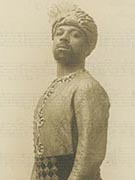
“Black Sound and the Archive”, the current exhibit at the Gilmore Music Library, highlights materials from the library’s Special Collections that document the history and significance of African-American sonic practices. In addition to historic sound recordings, the exhibit features an array of rare and unusual items from the library’s collections, such as an arrangement written by Mary Lou Williams, a document in Duke Ellington’s hand, and objects that belonged to J. Rosamond Johnson, the composer of “Lift Every Voice and Sing.
Among those objects are faded pajamas and a carved wooden cane. “The loungewear here accompanied by cane offers a glimpse of Johnson’s intimate sartorial style, the elegance and fashion ease that he maintained,” writes curator Daphne Brooks in the exhibition notes. “Like his fellow postbellum black theater peers, he valued clothing as a way to ‘redress’ the black body in the struggle for racial equality.”
The exhibit runs April 13-July 30, 2018; however, the pajamas will be on display only through May 21 because of their fragile state.
The Black Sound and the Archive Working Group at Yale University is a two-year initiative supported by Yale’s 320 York Humanities Grant that focuses on the history and significance of African-American sonic practices in tandem with a critical examination of the nature of archives. The group seeks to augment the very notion of what constitutes a black sound archive. Beyond historical sound recordings as such, African-American sonic practices are also embedded in a rich yet often opaque archive of extraordinary and everyday objects, photographs, narratives, performances, and repertoires.
The group is led by Professors Daphne Brooks (African American Studies, American Studies, Theater Studies, Women’s, Gender, and Sexuality Studies) and Brian Kane (Music), and includes faculty, graduate students, and undergrads from Yale and beyond. This exhibit is one of the multiple workshops, performances and other events produced by the group.